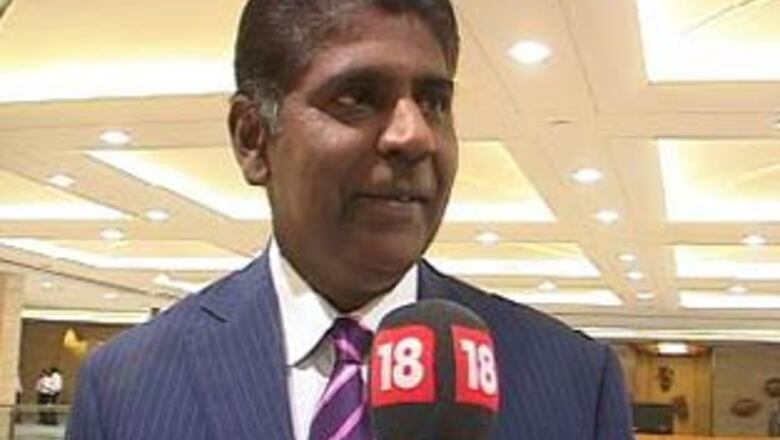
views
Chennai: India, a nation with a proud tennis tradition built on Wimbledon and Davis Cup exploits, is desperately seeking a male singles player who can help revive the game.
The grass courts of Wimbledon once inspired Indians like Ramanathan Krishnan to produce their best singles performances in grand slams but none has now entered the men's singles main draw since 2001.
"(Playing in) Wimbledon and Davis Cup, that is the dream as far as any Indian tennis player is concerned," said Krishnan, who reached the Wimbledon semi-finals in 1960 and 1961.
"Everyone considers Wimbledon as the Mecca of tennis and Davis Cup as the ultimate honour in representing the country," the 72-year-old told Reuters at his home in Chennai.
As the year's third grand slam kicks off on Monday, however, India's only main draw singles action will be confined to Sania Mirza, currently the women's Number 78.
India's best male player Somdev Devvarman, 24, is ranked 132nd and lost in the first round of qualifiers. Australian Open boys champion Yuki Bhambri, a future hope, is currently aiming to build senior rankings in low-key events at home.
In the past, India reached three Davis Cup finals while Krishnan, who charmed spectators with his touch game, produced India's best grand slam singles results.
His exploits inspired another generation of players led by Vijay Amritraj and Krishnan's son, Ramesh.
Amritraj, renowed for his Davis Cup exploits, used his height and a strong serve to become Asia Number One and was ranked 16th in the world in the early 1980s. He twice reached the quarter-finals at Wimbledon while the younger Ramesh, whose silky shots reminded fans of his father's game, took up the baton and made last eight appearances in the grasscourt grand slam as well as the US Open in 1987.
Ramesh also guided India into the Davis Cup final for a third time that year but the tap now appears to have run dry. India have not been in the Davis Cup World Group since 1998 after Leander Paes and Mahesh Bhupathi turned to doubles.
PAGE_BREAK
No Indian has cracked the top 100 in singles ranking since Paes, who won an Olympics singles bronze medal at Atlanta in 1996 and reached a career-high 73 in 1998 before going on to become the world's top ranked doubles pair with Bhupathi.
Grand slam title winners together, they will feature in the Wimbledon doubles with different partners this time but they will have no compatriots in the men's singles main draw.
Easy rounds
"Competition is (now) really high," said Krishnan, who runs a tennis academy with his son. "There is depth ... and our people have not been able to cope with that. When I played tennis there were only 200 or 300 players competing in the international arena, but today it runs into thousands," he said.
"Back then I could hope for a couple of easy rounds, even at Wimbledon I could expect one or two easy rounds before the quarter-finals.
"But today, the first round is tough. Even for a (Roger) Federer or (Rafa) Nadal, if they don't strike their best form on the first day they might meet somebody who might upset them."
Krishnan blamed a lack of funds and exposure for the decline of Indian tennis, despite its fast-growing economy. "We don't have sponsors for players, only for events," he sai.
Although there is huge enthusiasm among children for the game and tennis academies dotted across cities, players struggle to raise money to play abroad and garner rankings points.
All India Tennis Federation (AITA) secretary Anil Khanna, who also heads the Asian body, said travel costs were the key obstacle. "For an Indian, or for that matter for an Asian, to reach the top 100 is like climbing 29,000 feet, Mt. Everest," he said.
"All tournaments are centred around Europe, all points are there or in South America. Asia is a huge continent, tournaments are held here but our players hardly get any points because better-ranked players from Europe come here."
Khanna said there was a need to organise tournaments exclusively for Asian players. "We may get an occasional Leander or a Paradorn Srichaphan but you cannot sustain that," he said referring to the Thai who was ranked among the top 10 in the world a few years ago.
"Europe is a small continent with good roads and railway networks. Even to go to Thailand or Bhutan we have to fly. "At basic level, there are enough players in India like elsewhere. It is like rock climbing which everyone can do, but when it comes to mountaineering, then it gets tough.
"Talent will give up because the road for an Asian to reach the top 100 is impossible."
(Report by Sanjay Rajan; additional reporting by N.Ananthanarayanan in New Delhi. To query or comment on this story email [email protected])




















Comments
0 comment